Preface 兰氏化学手册
- 格式:pdf
- 大小:107.10 KB
- 文档页数:8
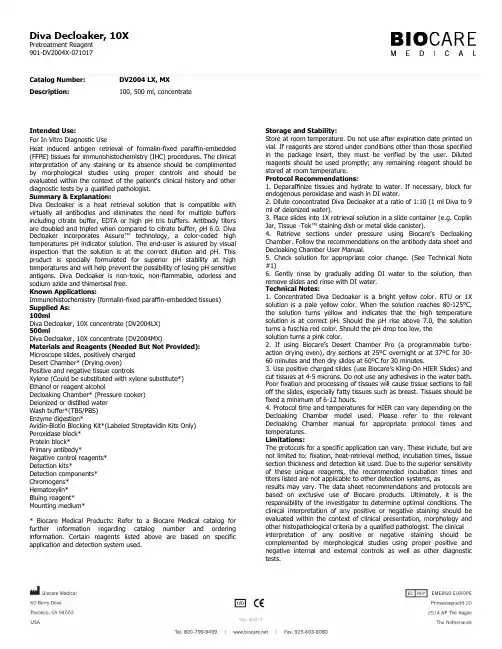
Intended Use:For In Vitro Diagnostic UseHeat induced antigen retrieval of formalin-fixed paraffin-embedded (FFPE) tissues for immunohistochemistry (IHC) procedures. The clinical interpretation of any staining or its absence should be complimented by morphological studies using proper controls and should be evaluated within the context of the patient's clinical history and other diagnostic tests by a qualified pathologist.Summary & Explanation:Diva Decloaker is a heat retrieval solution that is compatible with virtually all antibodies and eliminates the need for multiple buffers including citrate buffer, EDTA or high pH tris buffers. Antibody titers are doubled and tripled when compared to citrate buffer, pH 6.0. Diva Decloaker incorporates Assure™ tech nology, a color-coded high temperatures pH indicator solution. The end-user is assured by visual inspection that the solution is at the correct dilution and pH. This product is specially formulated for superior pH stability at high temperatures and will help prevent the possibility of losing pH sensitive antigens. Diva Decloaker is non-toxic, non-flammable, odorless and sodium azide and thimerosal free.Known Applications:Immunohistochemistry (formalin-fixed paraffin-embedded tissues) Supplied As:100mlDiva Decloaker, 10X concentrate (DV2004LX)500mlDiva Decloaker, 10X concentrate (DV2004MX)Materials and Reagents (Needed But Not Provided): Microscope slides, positively chargedDesert Chamber* (Drying oven)Positive and negative tissue controlsXylene (Could be substituted with xylene substitute*)Ethanol or reagent alcoholDecloaking Chamber* (Pressure cooker)Deionized or distilled waterWash buffer*(TBS/PBS)Enzyme digestion*Avidin-Biotin Blocking Kit*(Labeled Streptavidin Kits Only) Peroxidase block*Protein block*Primary antibody*Negative control reagents*Detection kits*Detection components*Chromogens*Hematoxylin*Bluing reagent*Mounting medium** Biocare Medical Products: Refer to a Biocare Medical catalog for further information regarding catalog number and ordering information. Certain reagents listed above are based on specific application and detection system used. Storage and Stability:Store at room temperature. Do not use after expiration date printed on vial. If reagents are stored under conditions other than those specified in the package insert, they must be verified by the user. Diluted reagents should be used promptly; any remaining reagent should be stored at room temperature.Protocol Recommendations:1. Deparaffinize tissues and hydrate to water. If necessary, block for endogenous peroxidase and wash in DI water.2. Dilute concentrated Diva Decloaker at a ratio of 1:10 (1 ml Diva to 9 ml of deionized water).3. Place slides into 1X retrieval solution in a slide container (e.g. Coplin Jar, Tissue -Tek™ staining dish or metal slide canister).4. Retrieve sections under pressure using Biocare's Decloaking Chamber. Follow the recommendations on the antibody data sheet and Decloaking Chamber User Manual.5. Check solution for appropriate color change. (See Technical Note #1)6. Gently rinse by gradually adding DI water to the solution, then remove slides and rinse with DI water.Technical Notes:1. Concentrated Diva Decloaker is a bright yellow color. RTU or 1X solution is a pale yellow color. When the solution reaches 80-125°C, the solution turns yellow and indicates that the high temperature solution is at correct pH. Should the pH rise above 7.0, the solution turns a fuschia red color. Should the pH drop too low, thesolution turns a pink color.2. If using Biocare’s Desert Chamber Pro (a programmable turbo-action drying oven), dry sections at 25ºC overnight or at 37ºC for 30-60 minutes and then dry slides at 60ºC for 30 minutes.3. Use positive char ged slides (use Biocare’s Kling-On HIER Slides) and cut tissues at 4-5 microns. Do not use any adhesives in the water bath. Poor fixation and processing of tissues will cause tissue sections to fall off the slides, especially fatty tissues such as breast. Tissues should be fixed a minimum of 6-12 hours.4. Protocol time and temperatures for HIER can vary depending on the Decloaking Chamber model used. Please refer to the relevant Decloaking Chamber manual for appropriate protocol times and temperatures.Limitations:The protocols for a specific application can vary. These include, but are not limited to: fixation, heat-retrieval method, incubation times, tissue section thickness and detection kit used. Due to the superior sensitivity of these unique reagents, the recommended incubation times and titers listed are not applicable to other detection systems, asresults may vary. The data sheet recommendations and protocols are based on exclusive use of Biocare products. Ultimately, it is the responsibility of the investigator to determine optimal conditions. The clinical interpretation of any positive or negative staining should be evaluated within the context of clinical presentation, morphology and other histopathological criteria by a qualified pathologist. The clinical interpretation of any positive or negative staining should be complemented by morphological studies using proper positive and negative internal and external controls as well as other diagnostic tests.Catalog Number: DV2004 LX, MX Description: 100, 500 ml, concentrateQuality Control:Refer to CLSI Quality Standards for Design and Implementation of Immunohistochemistry Assays; Approved Guideline-Second edition (I/LA28-A2). CLSI Wayne, PA, USA (). 2011 Precautions:1. This product is not classified as hazardous. The preservative used in this reagent is Proclin 300 and the concentration is less than 0.25%. Overexposure to Proclin 300 can cause skin and eye irritation and irritation to mucous membranes and upper respiratory tract. The concentration of Proclin 300 in this product does not meet the OSHA criteria for a hazardous substance. Wear disposable gloves when handling reagents.2. Specimens, before and after fixation, and all materials exposed to them should be handled as if capable of transmitting infection and disposed of with proper precautions. Never pipette reagents by mouth and avoid contacting the skin and mucous membranes with reagents and specimens. If reagents or specimens come in contact with sensitive areas, wash with copious amounts of water.3. Microbial contamination of reagents may result in an increase in nonspecific staining.4. Incubation times or temperatures other than those specified may give erroneous results. The user must validate any such change.5. Do not use reagent after the expiration date printed on the vial.6. The SDS is available upon request and is located at /.7. Consult OSHA, federal, state or local regulations for disposal of any toxic substances. Proclin is a trademark of Rohm and Haas Company, or of its subsidiaries or affiliates.Troubleshooting:Follow the antibody specific protocol recommendations according to data sheet provided. If atypical results occur, contact Biocare's Technical Support at 1-800-542-2002.。
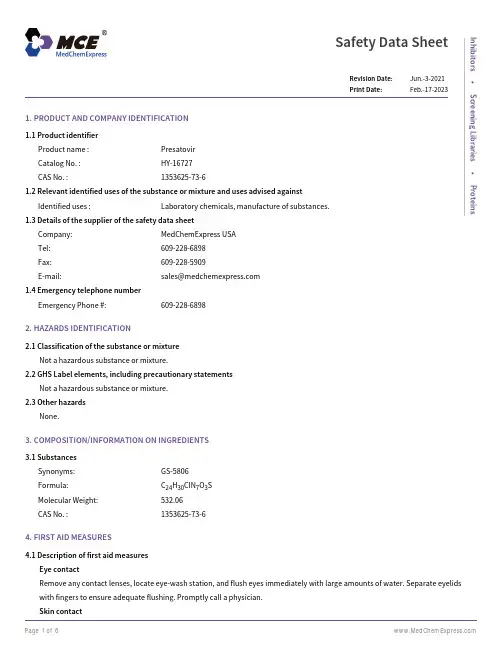
1. PRODUCT AND COMPANY IDENTIFICATION1.1 Product identifierProduct name :Presatovir Catalog No. :HY-16727CAS No. :1353625-73-61.2 Relevant identified uses of the substance or mixture and uses advised against Identified uses :Laboratory chemicals, manufacture of substances.1.3 Details of the supplier of the safety data sheetCompany:MedChemExpress USA Tel:609-228-6898Fax:609-228-5909E-mail:1.4 Emergency telephone numberEmergency Phone #:609-228-68982. HAZARDS IDENTIFICATION2.1 Classification of the substance or mixtureNot a hazardous substance or mixture.2.2 GHS Label elements, including precautionary statementsNot a hazardous substance or mixture.2.3 Other hazardsNone.3. COMPOSITION/INFORMATION ON INGREDIENTS3.1 SubstancesSynonyms:GS-5806Formula:C 24H 30ClN 7O 3S Molecular Weight:532.06CAS No. :1353625-73-64. FIRST AID MEASURES4.1 Description of first aid measuresEye contactRemove any contact lenses, locate eye-wash station, and flush eyes immediately with large amounts of water. Separate eyelids with fingers to ensure adequate flushing. Promptly call a physician. Skin contactSafety Data SheetRevision Date:Jun.-3-2021Print Date:Feb.-17-2023Inhibitors •Screening Libraries•ProteinsRinse skin thoroughly with large amounts of water. Remove contaminated clothing and shoes and call a physician.InhalationImmediately relocate self or casualty to fresh air. If breathing is difficult, give cardiopulmonary resuscitation (CPR). Avoid mouth-to-mouth resuscitation.IngestionWash out mouth with water; Do NOT induce vomiting; call a physician.4.2 Most important symptoms and effects, both acute and delayedThe most important known symptoms and effects are described in the labelling (see section 2.2).4.3 Indication of any immediate medical attention and special treatment neededTreat symptomatically.5. FIRE FIGHTING MEASURES5.1 Extinguishing mediaSuitable extinguishing mediaUse water spray, dry chemical, foam, and carbon dioxide fire extinguisher.5.2 Special hazards arising from the substance or mixtureDuring combustion, may emit irritant fumes.5.3 Advice for firefightersWear self-contained breathing apparatus and protective clothing.6. ACCIDENTAL RELEASE MEASURES6.1 Personal precautions, protective equipment and emergency proceduresUse full personal protective equipment. Avoid breathing vapors, mist, dust or gas. Ensure adequate ventilation. Evacuate personnel to safe areas.Refer to protective measures listed in sections 8.6.2 Environmental precautionsTry to prevent further leakage or spillage. Keep the product away from drains or water courses.6.3 Methods and materials for containment and cleaning upAbsorb solutions with finely-powdered liquid-binding material (diatomite, universal binders); Decontaminate surfaces and equipment by scrubbing with alcohol; Dispose of contaminated material according to Section 13.7. HANDLING AND STORAGE7.1 Precautions for safe handlingAvoid inhalation, contact with eyes and skin. Avoid dust and aerosol formation. Use only in areas with appropriate exhaust ventilation.7.2 Conditions for safe storage, including any incompatibilitiesKeep container tightly sealed in cool, well-ventilated area. Keep away from direct sunlight and sources of ignition.Recommended storage temperature:Powder-20°C 3 years4°C 2 yearsIn solvent-80°C 6 months-20°C 1 monthShipping at room temperature if less than 2 weeks.7.3 Specific end use(s)No data available.8. EXPOSURE CONTROLS/PERSONAL PROTECTION8.1 Control parametersComponents with workplace control parametersThis product contains no substances with occupational exposure limit values.8.2 Exposure controlsEngineering controlsEnsure adequate ventilation. Provide accessible safety shower and eye wash station.Personal protective equipmentEye protection Safety goggles with side-shields.Hand protection Protective gloves.Skin and body protection Impervious clothing.Respiratory protection Suitable respirator.Environmental exposure controls Keep the product away from drains, water courses or the soil. Cleanspillages in a safe way as soon as possible.9. PHYSICAL AND CHEMICAL PROPERTIES9.1 Information on basic physical and chemical propertiesAppearance SolidOdor No data availableOdor threshold No data availablepH No data availableMelting/freezing point No data availableBoiling point/range No data availableFlash point No data availableEvaporation rate No data availableFlammability (solid, gas)No data availableUpper/lower flammability or explosive limits No data availableVapor pressure No data availableVapor density No data availableRelative density No data availableWater Solubility No data availablePartition coefficient No data availableAuto-ignition temperature No data availableDecomposition temperature No data availableViscosity No data availableExplosive properties No data availableOxidizing properties No data available9.2 Other safety informationNo data available.10. STABILITY AND REACTIVITY10.1 ReactivityNo data available.10.2 Chemical stabilityStable under recommended storage conditions.10.3 Possibility of hazardous reactionsNo data available.10.4 Conditions to avoidNo data available.10.5 Incompatible materialsStrong acids/alkalis, strong oxidising/reducing agents.10.6 Hazardous decomposition productsUnder fire conditions, may decompose and emit toxic fumes.Other decomposition products - no data available.11.TOXICOLOGICAL INFORMATION11.1 Information on toxicological effectsAcute toxicityClassified based on available data. For more details, see section 2Skin corrosion/irritationClassified based on available data. For more details, see section 2Serious eye damage/irritationClassified based on available data. For more details, see section 2Respiratory or skin sensitizationClassified based on available data. For more details, see section 2Germ cell mutagenicityClassified based on available data. For more details, see section 2CarcinogenicityIARC: No component of this product present at a level equal to or greater than 0.1% is identified as probable, possible or confirmed human carcinogen by IARC.ACGIH: No component of this product present at a level equal to or greater than 0.1% is identified as a potential or confirmed carcinogen by ACGIH.NTP: No component of this product present at a level equal to or greater than 0.1% is identified as a anticipated or confirmed carcinogen by NTP.OSHA: No component of this product present at a level equal to or greater than 0.1% is identified as a potential or confirmed carcinogen by OSHA.Reproductive toxicityClassified based on available data. For more details, see section 2Specific target organ toxicity - single exposureClassified based on available data. For more details, see section 2Specific target organ toxicity - repeated exposureClassified based on available data. For more details, see section 2Aspiration hazardClassified based on available data. For more details, see section 2Additional informationThis information is based on our current knowledge. However the chemical, physical, and toxicological properties have not been completely investigated.12. ECOLOGICAL INFORMATION12.1 ToxicityNo data available.12.2 Persistence and degradabilityNo data available.12.3 Bioaccumlative potentialNo data available.12.4 Mobility in soilNo data available.12.5 Results of PBT and vPvB assessmentPBT/vPvB assessment unavailable as chemical safety assessment not required or not conducted.12.6 Other adverse effectsNo data available.13. DISPOSAL CONSIDERATIONS13.1 Waste treatment methodsProductDispose substance in accordance with prevailing country, federal, state and local regulations.Contaminated packagingConduct recycling or disposal in accordance with prevailing country, federal, state and local regulations.14. TRANSPORT INFORMATIONDOT (US)Proper shipping name: Not dangerous goodsUN number: -Class: -Packing group: -IMDGProper shipping name: Not dangerous goodsUN number: -Class: -Packing group: -IATAProper shipping name: Not dangerous goodsUN number: -Class: -Packing group: -15. REGULATORY INFORMATIONSARA 302 Components:No chemicals in this material are subject to the reporting requirements of SARA Title III, Section 302.SARA 313 Components:This material does not contain any chemical components with known CAS numbers that exceed the threshold (De Minimis) reporting levels established by SARA Title III, Section 313.SARA 311/312 Hazards:No SARA Hazards.Massachusetts Right To Know Components:No components are subject to the Massachusetts Right to Know Act.Pennsylvania Right To Know Components:No components are subject to the Pennsylvania Right to Know Act.New Jersey Right To Know Components:No components are subject to the New Jersey Right to Know Act.California Prop. 65 Components:This product does not contain any chemicals known to State of California to cause cancer, birth defects, or anyother reproductive harm.16. OTHER INFORMATIONCopyright 2023 MedChemExpress. The above information is correct to the best of our present knowledge but does not purport to be all inclusive and should be used only as a guide. The product is for research use only and for experienced personnel. It must only be handled by suitably qualified experienced scientists in appropriately equipped and authorized facilities. The burden of safe use of this material rests entirely with the user. MedChemExpress disclaims all liability for any damage resulting from handling or from contact with this product.Caution: Product has not been fully validated for medical applications. For research use only.Tel:609-228-6898Fax:609-228-5909E-mail:***********************Address: 1 Deer Park Dr, Suite Q, Monmouth Junction, NJ 08852, USA。
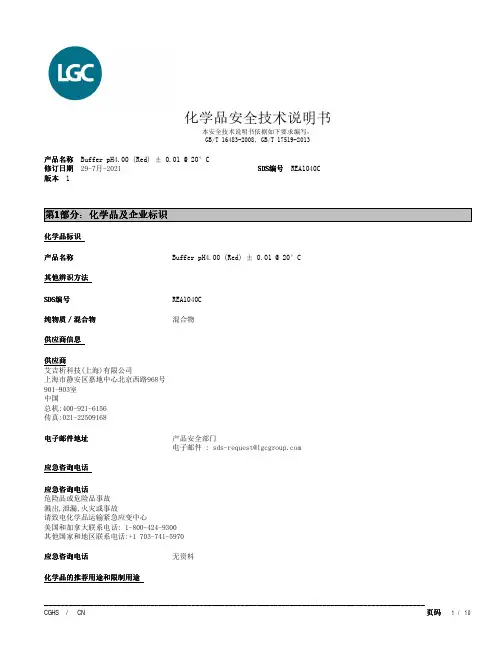
化学品安全技术说明书本安全技术说明书依据如下要求编写:GB/T 16483-2008, GB/T 17519-2013产品名称 Buffer pH4.00 (Red) ± 0.01 @ 20°C 修订日期 29-7月-2021 SDS编号 REA1040C版本 1第1部分第1部分::化学品及企业标识化学品标识 产品名称 Buffer pH4.00 (Red) ± 0.01 @ 20°C其他辨识方法 SDS编号 REA1040C 纯物质纯物质//混合物 混合物供应商信息电子邮件地址产品安全部门电子邮件:************************应急咨询电话应急咨询电话危险品或危险品事故 溅出,泄漏,火灾或事故请致电化学品运输紧急应变中心美国和加拿大联系电话: 1-800-424-9300 其他国家和地区联系电话:+1 703-741-5970 应急咨询电话无资料化学品的推荐用途和限制用途供应商艾吉析科技(上海)有限公司上海市静安区嘉地中心北京西路968号 901-903室 中国总机:400-921-6156 传真*************_____________________________________________________________________________________________化学品安全技术说明书本安全技术说明书依据如下要求编写:GB/T 16483-2008, GB/T 17519-2013产品名称 Buffer pH4.00 (Red) ± 0.01 @ 20°C SDS编号 REA1040C修订日期 29-7月-2021推荐用途 实验室用途 限制用途无资料第2部分第2部分::危险性概述GHS危险性类别皮肤腐蚀/刺激 类别2 严重眼损伤/眼刺激 类别2A标签要素信号词警告危险性说明 造成皮肤刺激造成严重眼刺激防范说明 预防措施作业后彻底清洗脸部、手部和任何暴露的皮肤戴防护手套/穿防护服/戴防护眼罩/戴防护面具事故响应如皮肤沾染:用大量水和肥皂清洗如发生皮肤刺激:求医/就诊脱掉受沾染的衣服,清洗后方可重新使用如进入眼睛:用水小心冲洗几分钟。
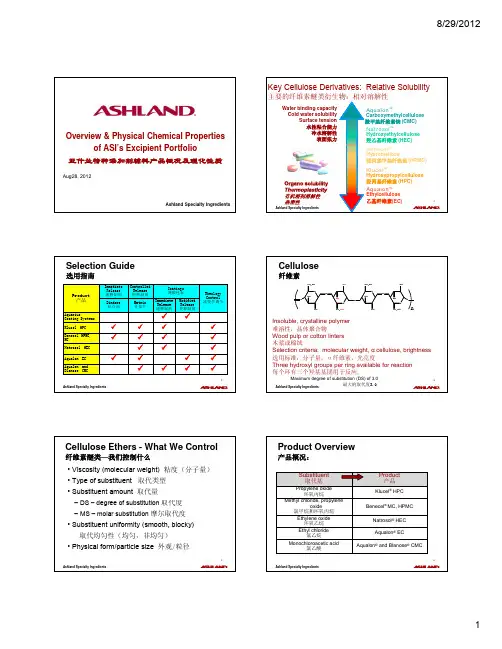
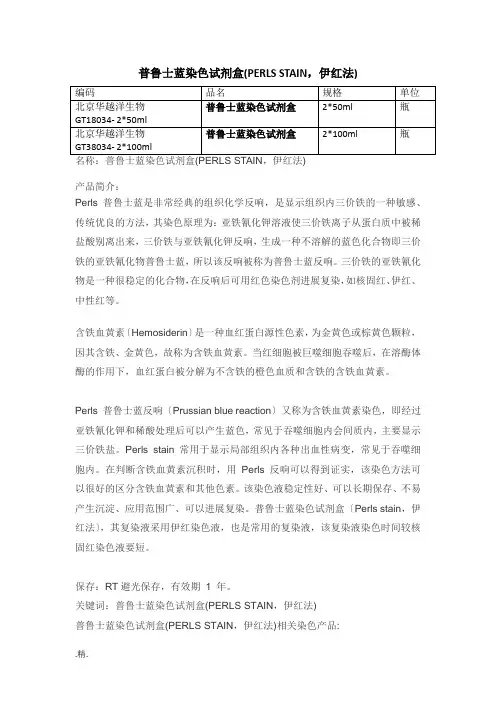
普鲁士蓝染色试剂盒(PERLS STAIN,伊红法)
产品简介:
Perls 普鲁士蓝是非常经典的组织化学反响,是显示组织内三价铁的一种敏感、传统优良的方法,其染色原理为:亚铁氰化钾溶液使三价铁离子从蛋白质中被稀盐酸别离出来,三价铁与亚铁氰化钾反响,生成一种不溶解的蓝色化合物即三价铁的亚铁氰化物普鲁士蓝,所以该反响被称为普鲁士蓝反响。
三价铁的亚铁氰化物是一种很稳定的化合物,在反响后可用红色染色剂进展复染,如核固红、伊红、中性红等。
含铁血黄素〔Hemosiderin〕是一种血红蛋白源性色素,为金黄色或棕黄色颗粒,因其含铁、金黄色,故称为含铁血黄素。
当红细胞被巨噬细胞吞噬后,在溶酶体酶的作用下,血红蛋白被分解为不含铁的橙色血质和含铁的含铁血黄素。
Perls 普鲁士蓝反响〔Prussian blue reaction〕又称为含铁血黄素染色,即经过亚铁氰化钾和稀酸处理后可以产生蓝色,常见于吞噬细胞内会间质内,主要显示三价铁盐。
Perls stain 常用于显示局部组织内各种出血性病变,常见于吞噬细胞内。
在判断含铁血黄素沉积时,用Perls 反响可以得到证实,该染色方法可以很好的区分含铁血黄素和其他色素。
该染色液稳定性好、可以长期保存、不易产生沉淀、应用范围广、可以进展复染。
普鲁士蓝染色试剂盒〔Perls stain,伊红法〕,其复染液采用伊红染色液,也是常用的复染液,该复染液染色时间较核固红染色液要短。
保存:RT避光保存,有效期 1 年。
关键词:普鲁士蓝染色试剂盒(PERLS STAIN,伊红法)
普鲁士蓝染色试剂盒(PERLS STAIN,伊红法)相关染色产品:。
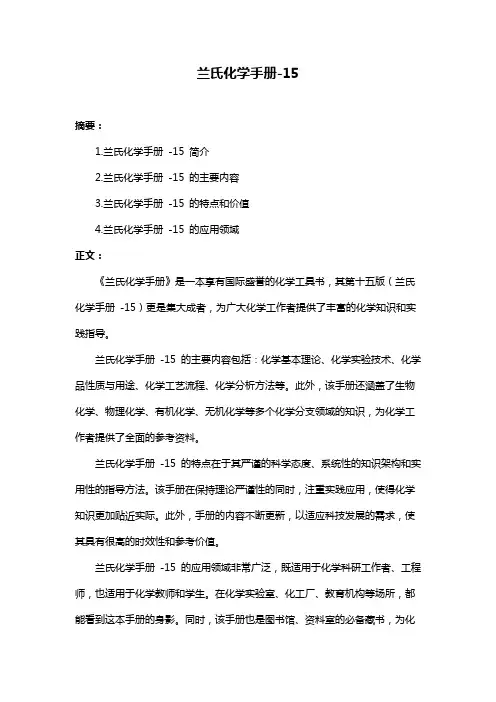
兰氏化学手册-15
摘要:
1.兰氏化学手册-15 简介
2.兰氏化学手册-15 的主要内容
3.兰氏化学手册-15 的特点和价值
4.兰氏化学手册-15 的应用领域
正文:
《兰氏化学手册》是一本享有国际盛誉的化学工具书,其第十五版(兰氏化学手册-15)更是集大成者,为广大化学工作者提供了丰富的化学知识和实践指导。
兰氏化学手册-15 的主要内容包括:化学基本理论、化学实验技术、化学品性质与用途、化学工艺流程、化学分析方法等。
此外,该手册还涵盖了生物化学、物理化学、有机化学、无机化学等多个化学分支领域的知识,为化学工作者提供了全面的参考资料。
兰氏化学手册-15 的特点在于其严谨的科学态度、系统性的知识架构和实用性的指导方法。
该手册在保持理论严谨性的同时,注重实践应用,使得化学知识更加贴近实际。
此外,手册的内容不断更新,以适应科技发展的需求,使其具有很高的时效性和参考价值。
兰氏化学手册-15 的应用领域非常广泛,既适用于化学科研工作者、工程师,也适用于化学教师和学生。
在化学实验室、化工厂、教育机构等场所,都能看到这本手册的身影。
同时,该手册也是图书馆、资料室的必备藏书,为化
学爱好者提供了丰富的学习资源。
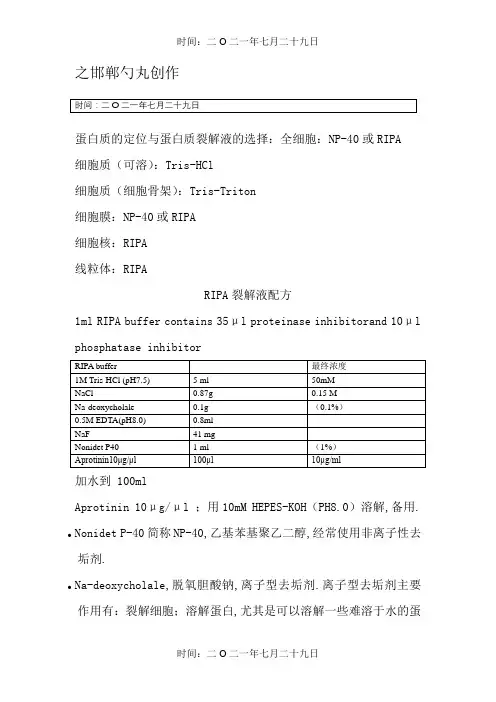
之邯郸勺丸创作蛋白质的定位与蛋白质裂解液的选择:全细胞:NP-40或RIPA细胞质(可溶):Tris-HCl细胞质(细胞骨架):Tris-Triton细胞膜:NP-40或RIPA细胞核:RIPA线粒体:RIPARIPA裂解液配方1ml RIPA buffer contains 35μl proteinase inhibitorand 10μl phosphatase inhibitor加水到 100mlAprotinin 10μg/μl ;用10mM HEPES-KOH(PH8.0)溶解,备用.●Nonidet P-40简称NP-40,乙基苯基聚乙二醇,经常使用非离子性去垢剂.●Na-deoxycholale,脱氧胆酸钠,离子型去垢剂.离子型去垢剂主要作用有:裂解细胞;溶解蛋白,尤其是可以溶解一些难溶于水的蛋白,如膜蛋白等;很适合做WB,但在Co-IP中使用,需要谨慎.●亮抑霉肽(Leupeptin):抑制丝氨酸蛋白酶包含胰蛋白酶、纤溶酶、猪胰激肽原酶)和半胱氨酸蛋白酶(包含木瓜蛋白酶和组织蛋白酶B)●抑肽素A(Pepstatin A)抑制各类天门冬氨酸蛋白酶,例如组织蛋白酶D、肾素、胃蛋白酶、细菌天门冬氨酸蛋白酶和HIV蛋白酶;●胰凝乳蛋白酶抑制剂(Chymostatin)抑制具有糜蛋白酶类特异性丝氨酸蛋白酶(包含糜蛋白酶、胃促胰酶、组织蛋白酶 G)和大多数丝氨酸蛋白酶(包含组织蛋白酶B,H,L)●抗木瓜蛋白酶(Antipain)抑制木瓜蛋白酶、胰蛋白酶和纤溶酶.●氟化钠抑制酸性磷酸酶●正钒酸钠:抑制碱性磷酸酶和酪氨酸磷酸酶(tyrosine phosphatase)●焦磷酸钠(sodium pyrophosphate):抑制丝氨酸-苏氨酸磷酸酶(serine-threonine phosphatase) .在与蛋白相关的检测中,首先最关头的一步即是蛋白质的提取.蛋白质的提取过程中,我们要经常加和蛋白酶抑制剂以避免蛋白质的降解.另外在磷酸化蛋白的研究过程中,磷酸酶抑制剂也是必不成少的,本文总结了经常使用的蛋白酶抑制剂PMSF,Leupeptin 亮肽素,Aprotinin抑肽酶,Pepstatin胃蛋白酶抑制剂,EDTA-Na2等以及磷酸酶抑制剂NaF氟化钠,Na3VO4 原矾酸钠 ,BETA-glycerophosphate 甘油磷酸钠,Na2P2O4 焦磷酸钠等.对这些蛋白酶抑制剂的溶解配制,贮存液与任务液浓度,保管都做了详细的说明.蛋白酶抑制剂PMSF:特性:丝氨酸蛋白酶抑制剂,如胰凝乳蛋白酶,胰蛋白酶和凝血酶,也抑制半胱氨酸蛋白酶如木瓜蛋白酶(可逆的地面处理).溶解性:溶于异丙醇,乙醇,甲醇和丙二醇果>10mg/ml.在水溶液中不稳定.在100%异丙醇, +25℃时稳定至少9个月份子量:174.2使用:贮存浓度:200mM,任务浓度:1mMLeupeptin 亮肽素特性:抑制丝氨酸和半胱氨酸蛋白酶如胰蛋白酶,木瓜蛋白酶,纤溶酶,和组织蛋白酶B溶解性:高度溶于水(1mg/ml).4℃一周稳定,分红小份冷冻在-20℃至少6个月份子量:C20H38N6O4 x 1/2 H2SO4:475.6C20H38N6O4 x 1/2 H2SO4 x H2O:493.6使用:贮存浓度:1mg/ml,任务浓度0.5 ug/ml (1mM)Aprotinin抑肽酶特性:丝氨酸蛋白酶抑制剂,抑制纤维蛋白溶酶, 激肽释放酶,胰蛋白酶,糜蛋白酶的高活性.不抑制凝血酶或因子X.溶解性:易溶于水(10mg/ml)或缓冲液(例如,tris,0.1M,pH8.0).pH 约7-8的溶液在4℃可保管1周,分装保管在-20℃可至少保管6个月.避免频频冻融, pH>12.8的碱性环境可使其灭活.份子量:6,512使用:贮存浓度:1mg/ml, 任务浓度:0.06–2.0 ug/ml(0.01–0.3 uM)Pepstatin胃蛋白酶抑制剂特性:抑制天冬氨酸(酸)蛋白酶如胃蛋白酶,肾素,组织蛋白酶D,凝乳酶, 许多微生物酸性蛋白酶溶解性:溶于甲醇约1mg/ml;可溶于乙醇,过夜溶解可达到1 mg/ml;在6当量乙酸中溶解度为300ug/ml.4℃稳定一周,分装储存于-20℃时可保管1个月份子量: 685.9使用:贮存浓度:1mg/ml,使用浓度:0.7 μg/ml(1μM)EDTA-Na2特性:金属蛋白酶抑制剂溶解性:溶于水至0.5M,在pH8-9的条件下,4℃稳定至少6个月份子量: 372.24使用:任务浓度:0.2–0.5 mg/ml(0.5–1.3 mM),不需现用现配,在溶液pH值调至8-9时再加入.磷酸酶抑制剂NaF氟化钠溶解性:溶于水份子量: 41.99使用:贮存液:5M 任务浓度:10-20mMNa3VO4 原矾酸钠份子量:183.91溶解性:溶于水,我们采办过来的是原矾酸钠.原矾酸钠需要经过处理以后才干成为激活的矾酸钠,激活的矾酸钠才具有抑制去磷酸化的作用.原矾酸钠酿成激活的矾酸钠的过程是:100mM原矾酸钠激活储存液配制(1).取0.183克的原矾酸钠溶解于10ml的双蒸水中,加酸调节PH至10(颜色变黄)(2).煮至无色(3).室温冷却(4).重调PH至10(5)重复(1)(2)(3)(4)直至溶液坚持无色,并且PH稳定于10,分装100ul/管,每10ml裂解液加一管.(终浓度为1mM),-20度保管.使用:贮存液:100mM 任务浓度:1mMBETA-glycerophosphate 甘油磷酸钠溶解性:溶于水份子量:306.11使用:贮存液:100mM 任务浓度:25mMNa2P2O4 焦磷酸钠溶解性:溶于水份子量:265.9贮存液:100mM, 任务浓度:1-2 mMSDS ,NP-40 ,TritonX-100这三种去垢剂的作用是不合的,或者说作用力量强弱不合.SDS属于离子型去垢剂,最厉害,基本可以把细胞完全破掉,DNA会释放出来,裂解液变得很粘稠.NP-40是很温和的去垢剂,1%浓度的基本可以破坏掉胞膜,而对核膜破坏的作用弱,结合特定的buffer可以获得胞浆蛋白.TritonX-100的能力介于NP40和SDS之间,偏向于NP40,也是经常使用的细胞裂解液成分之一,在呵护蛋白活性方面有一定作用(SDS 基本会使蛋白变性失活).Brij Buffer I。
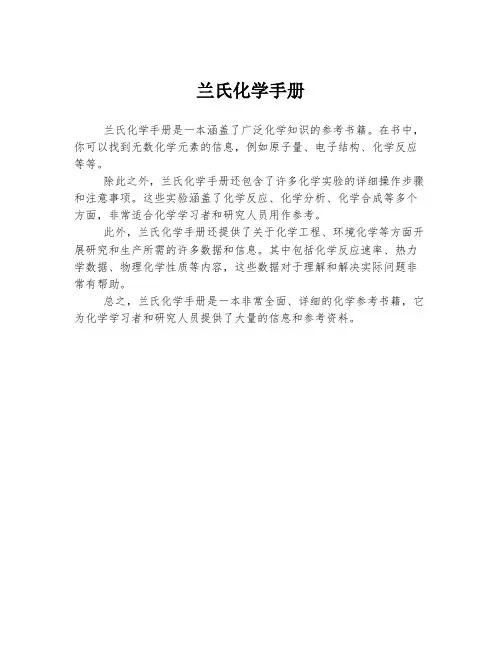
兰氏化学手册
兰氏化学手册是一本涵盖了广泛化学知识的参考书籍。
在书中,你可以找到无数化学元素的信息,例如原子量、电子结构、化学反应等等。
除此之外,兰氏化学手册还包含了许多化学实验的详细操作步骤和注意事项。
这些实验涵盖了化学反应、化学分析、化学合成等多个方面,非常适合化学学习者和研究人员用作参考。
此外,兰氏化学手册还提供了关于化学工程、环境化学等方面开展研究和生产所需的许多数据和信息。
其中包括化学反应速率、热力学数据、物理化学性质等内容,这些数据对于理解和解决实际问题非常有帮助。
总之,兰氏化学手册是一本非常全面、详细的化学参考书籍,它为化学学习者和研究人员提供了大量的信息和参考资料。
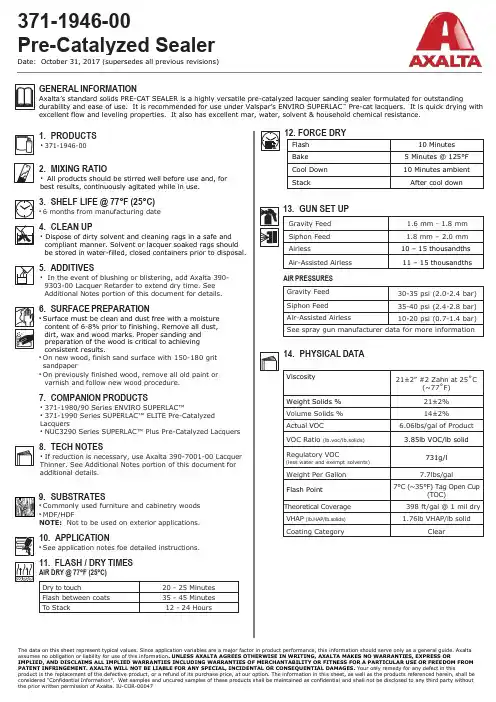
The data on this sheet represent typical values. Since application variables are a major factor in product performance, this information should serve only as a general guide. Axaltaassumes no obligation or liability for use of this information . UNLESS AXALTA AGREES OTHERWISE IN WRITING, AXALTA MAKES NO WARRANTIES, EXPRESS ORIMPLIED, AND DISCLAIMS ALL IMPLIED WARRANTIES INCLUDING WARRANTIES OF MERCHANTABILITY OR FITNESS FOR A PARTICULAR USE OR FREEDOM FROM PATENT INFRINGEMENT. AXALTA WILL NOT BE LIABLE FOR ANY SPECIAL, INCIDENTAL OR CONSEQUENTIAL DAMAGES. Your only remedy for any defect in thisproduct is the replacement of the defective product, or a refund of its purchase price, at our option. The information in this sheet, as well as the products referenced herein, shall beGENERAL INFORMATIONAxalta ’s standard solids PRE-CAT SEALER is a highly versatile pre-catalyzed lacquer sanding sealer formulated for outstandingdurability and ease of use. It is recommended for use under Valspar’s ENVIRO SUPERLAC ™ Pre-cat lacquers. It is quick drying with excellent flow and leveling properties. It also has excellent mar, water, solvent & household chemical resistance.1. PRODUCTS• 371-1946-002. MIXING RATIO• All products should be stirred well before use and, forbest results, continuously agitated while in use.3. SHELF LIFE @ 77°F (25°C)• 6 months from manufacturing date4. CLEAN UP• Dispose of dirty solvent and cleaning rags in a safe andcompliant manner. Solvent or lacquer soaked rags should be stored in water-filled, closed containers prior to disposal.5. ADDITIVES• In the event of blushing or blistering, add Axalta 390-9303-00 Lacquer Retarder to extend dry time. See Additional Notes portion of this document for details.6. SURFACE PREPARATION• Surface must be clean and dust free with a moisturecontent of 6-8% prior to finishing. Remove all dust, dirt, wax and wood marks. Proper sanding and preparation of the wood is critical to achieving consistent results.• On new wood, finish sand surface with 150-180 grit sandpaper• On previously finished wood, remove all old paint or varnish and follow new wood procedure.7. COMPANION PRODUCTS• 371-1980/90 Series ENVIRO SUPERLAC ™• 371-1990 Series SUPERLAC ™ ELITE Pre-CatalyzedLacquers• NUC3290 Series SUPERLAC ™ Plus Pre-Catalyzed Lacquers8. TECH NOTES• If reduction is necessary, use Axalta 390-7001-00 LacquerThinner. See Additional Notes portion of this document for additional details.9. SUBSTRATES• Commonly used furniture and cabinetry woods • MDF/HDFNOTE: Not to be used on exterior applications.10. APPLICATION• See application notes foe detailed instructions.11. FLASH / DRY TIMESAIR DRY @ 77°F (25°C)AIR PRESSURES14. PHYSICAL DATAproduct is the replacement of the defective product, or a refund of its purchase price, at our option. The information in this sheet, as well as the products referenced herein, shall be。
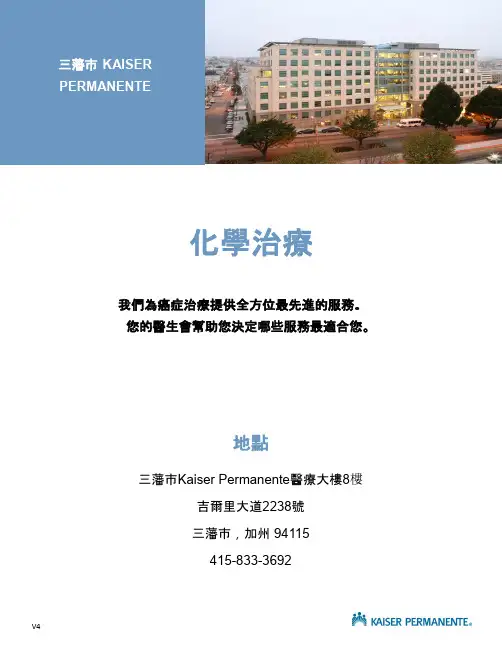
化學治療我們為癌症治療提供全方位最先進的服務。
您的醫生會幫助您決定哪些服務最適合您。
地點三藩市Kaiser Permanente醫療大樓8樓吉爾里大道2238號三藩市,加州 94115415-833-3692尊敬的 Kaiser 会员:欢迎您来到旧金山肿瘤科。
您的医生以及我们多学科团队的其他成员会在这里为您的抗癌之路提供帮助。
请查看随附由我们的团队以及患者咨询委员会编制的化疗课程手册,这是我们向您提供的一项资源。
我们请您在参加化疗课程时携带本手册。
我们鼓励您登录:/mydoctor/sanfrancisco/cancer。
您可在Supportive Services(支持性服务)选项下找到该幻灯片。
请观看题为“San Francisco Introduction to Chemotherapy Class”的简短幻灯片。
广东话https:///watch?v=Yx6CxaVm9s0普通话 https:///watch?v=oWMlFtJSyhU如有任何问题,敬请拨打总机号码联系我们的团队:415-833-3692诚致敬意,您的肿瘤护理团队目錄腫瘤科電話號碼 (4)預先提示 (5)地圖和停車………………………………………………………………………..…….…..6-7什麼是化療?.…………………………………………………………………..……..…….7-9化療對您的影響………………………………………..…..…..…..…..…….…...10-25營養…………………………………………………………………………………26-27化療後…………………………………………………………………….…..…..…...…...28-30支援資源……………………………………………………………………..…..……..….31-32健康教育資源…………………………………………………..…..…..…….…...33-35針灸 (36)表格…………………………………………………………………………….……37-39社區資源……………………………………………………..…..……………..….40-42附件購物清單 (43)臨床試驗 (44)術語表 (45)本手冊和Power Point演示文稿可在以下網址線上獲取/mydoctor/sanfrancisco/cancer 支援護理部分。
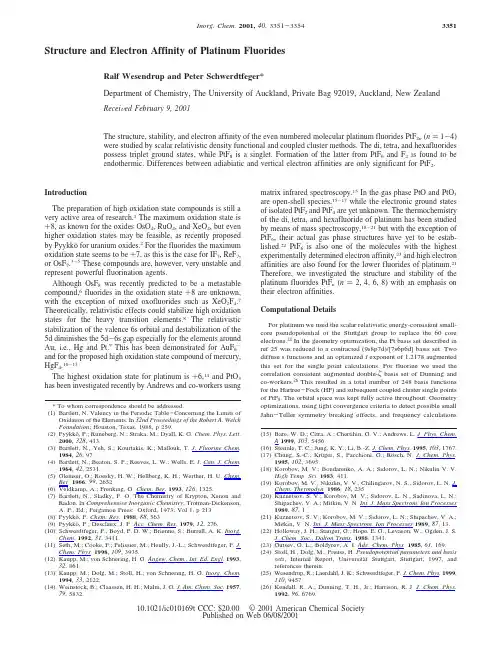
Structure and Electron Affinity of Platinum FluoridesRalf Wesendrup and Peter Schwerdtfeger*Department of Chemistry,The University of Auckland,Private Bag92019,Auckland,New ZealandRecei V ed February9,2001The structure,stability,and electron affinity of the even numbered molecular platinum fluorides PtF2n(n)1-4)were studied by scalar relativistic density functional and coupled cluster methods.The di,tetra,and hexafluoridespossess triplet ground states,while PtF8is a singlet.Formation of the latter from PtF6and F2is found to beendothermic.Differences between adiabiatic and vertical electron affinities are only significant for PtF2.IntroductionThe preparation of high oxidation state compounds is still a very active area of research.1The maximum oxidation state is +8,as known for the oxides OsO4,RuO4,and XeO4,but even higher oxidation states may be feasible,as recently proposed by Pyykko¨for uranium oxides.2For the fluorides the maximum oxidation state seems to be+7,as this is the case for IF7,ReF7, or OsF7.3-5These compounds are,however,very unstable and represent powerful fluorination agents.Although OsF8was recently predicted to be a metastable compound,6fluorides in the oxidation state+8are unknown, with the exception of mixed oxofluorides such as XeO2F4.7 Theoretically,relativistic effects could stabilize high oxidation states for the heavy transition elements.8The relativistic stabilization of the valence6s orbital and destabilization of the 5d diminishes the5d-6s gap especially for the elements around Au,i.e.,Hg and Pt.9This has been demonstrated for AuF6-and for the proposed high oxidation state compound of mercury, HgF4.10-13The highest oxidation state for platinum is+6,14and PtO3 has been investigated recently by Andrews and co-workers using matrix infrared spectroscopy.15In the gas phase PtO and PtO3 are open-shell species,15-17while the electronic ground states of isolated PtF2and PtF4are yet unknown.The thermochemistry of the di,tetra,and hexafluoride of platinum has been studied by means of mass spectroscopy,18-21but with the exception of PtF6,their actual gas phase structures have yet to be estab-lished.22PtF6is also one of the molecules with the highest experimentally determined electron affinity,23and high electron affinities are also found for the lower fluorides of platinum.21 Therefore,we investigated the structure and stability of the platinum fluorides PtF n(n)2,4,6,8)with an emphasis on their electron affinities.Computational DetailsFor platinum we used the scalar relativistic energy-consistent small-core pseudopotential of the Stuttgart group to replace the60core electrons.24In the geometry optimization,the Pt basis set described in ref25was reduced to a contracted(9s8p7d)/[7s6p6d]basis set.Two diffuse s functions and an optimized f exponent of1.2178augmented this set for the single point calculations.For fluorine we used the correlation consistent augmented double- basis set of Dunning and co-workers.26This resulted in a total number of248basis functions for the Hartree-Fock(HF)and subsequent coupled cluster single points of PtF8.The orbital space was kept fully active throughout.Geometry optimizations,using tight convergence criteria to detect possible small Jahn-Teller symmetry breaking effects,and frequency calculations*To whom correspondence should be addressed.(1)Bartlett,N.Valency in the Periodic Table-Concerning the Limits ofOxidation of the Elements.In32nd Proceedings of the Robert A.WelchFoundation;Houston,Texas,1988;p259.(2)Pyykko¨,P.;Runeberg,N.;Straka,M.;Dyall,K.G.Chem.Phys.Lett.2000,328,413.(3)Bartlett,N.;Yeh,S.;Kourtakis,K.;Mallouk,T.J.Fluorine Chem.1984,26,97.(4)Bartlett,N.;Beaton,S.P.;Reeves,L.W.;Wells,E.J.Can.J.Chem.1964,42,2531.(5)Glemser,O.;Roesky,H.W.;Hellberg,K.H.;Werther,H.U.Chem.Ber.1966,99,2652.(6)Veldkamp,A.;Frenking,G.Chem.Ber.1993,126,1325.(7)Bartlett,N.;Sladky,F.O.The Chemistry of Krypton,Xenon andRadon.In Comprehensi V e Inorganic Chemistry;Trotman-Dickenson,A.F.,Ed.;Pergamon Press:Oxford,1973;Vol1,p213.(8)Pyykko¨,P.Chem.Re V.1988,88,563.(9)Pyykko¨,P.;Desclaux,J.P.Acc.Chem.Res.1979,12,276.(10)Schwerdtfeger,P.;Boyd,P.D.W.;Brienne,S.;Burrell,A.K.Inorg.Chem.1992,31,3411.(11)Seth,M.;Cooke,F.;Pelissier,M.;Heully,J.-L.;Schwerdtfeger,P.J.Chem.Phys.1998,109,3935.(12)Kaupp,M.;von Schnering,H.G.Angew.Chem.,Int.Ed.Engl.1993,32,861.(13)Kaupp,M.;Dolg,M.;Stoll,H.;von Schnering,H.G.Inorg.Chem.1994,33,2122.(14)Weinstock,B.;Claassen,H.H.;Malm,J.G.J.Am.Chem.Soc.1957,79,5832.(15)Bare,W.D.;Citra,A.;Chertihin,G.V.;Andrews,L.J.Phys.Chem.A1999,103,5456.(16)Steimle,T.C.;Jung,K.Y.;Li,B.-Z.J.Chem.Phys.1995,103,1767.(17)Chung,S.-C.;Kru¨ger,S.;Pacchioni,G.;Ro¨sch,N.J.Chem.Phys.1995,102,3695.(18)Korobov,M.V.;Bondarenko,A.A.;Sidorov,L.N.;Nikulin V.V.High Temp.Sci.1983,411.(19)Korobov,M.V.;Nikulin,V.V.;Chilingarov,N.S.;Sidorov,L.N.J.Chem.Thermodyn.1986,18,235.(20)Kuznetsov,S.V.;Korobov,M.V.;Sidorov,L.N.;Sadinova,L.N.;Shipachev,V.A.;Mitkin,V.N.Int.J.Mass Spectrom.Ion Processes 1989,87,1.(21)Kuznetsov,S.V.;Korobov,M.V.;Sidorov,L.N.;Shipachev,V.A.;Mitkin,V.N.Int.J.Mass Spectrom.Ion Processes1989,87,13.(22)Holloway,J.H.;Stanger,G.;Hope,E.G.;Levason,W.;Ogden,J.S.J.Chem.Soc.,Dalton Trans.1988,1341.(23)Gutsev,G.L.;Boldyrev,A.I.Ad V.Chem.Phys.1985,61,169.(24)Stoll,H.;Dolg,M.;Preuss,H.Pseudopotential parameters and basissets;Internal Report,Universita¨t Stuttgart,Stuttgart,1997,and references therein.(25)Wesendrup,R.;Laerdahl,J.K.;Schwerdtfeger,P.J.Chem.Phys.1999,110,9457.(26)Kendall,R.A.;Dunning,T.H.,Jr.;Harrison,R.J.J.Chem.Phys.1992,96,6769.3351Inorg.Chem.2001,40,3351-335410.1021/ic010169t CCC:$20.00©2001American Chemical SocietyPublished on Web06/08/2001were performed at the density functional B3LYP level using Gaussian98followed by a thermodynamical analysis for the various decomposition processes of PtF 2n (n )1,2,3,4).27The optimized structures for the neutral species are all minima as checked by frequency analyses.28The singlet -triplet energy separation was determined for the structures where the triplet state represents the electronic ground state.Quintet states for the neutral and quartet states for the anionic species are too high in energy and were not considered.A comparison of different minimum structures for PtF 2optimized at B3LYP,Møller -Plesset second-order (MP2),and CCSD(T)level reveals a reasonable agreement between the methods and justifies our choice of the less expensive B3LYP method for the geometry optimization.For the higher fluorides,coupled cluster single points were calculated at the B3LYP geometries using the program AcesII.29To obtain the vertical electron affinities (EA),the energies of the anions were calculated at the geometry of the corresponding neutral molecules.For comparison we also optimized the structures of PtF 2-,PtF 4-,and PtF 6-to determine the adiabatic electron affinities.As the difference between both EAs is minute,only the vertical EA was calculated for PtF 8.The doubly charged free species PtF 22-and PtF 42-are not stable with respect to loss of an electron according to our computations and will therefore not be discussed.Although spin -orbit splitting is significant in the platinum atom,its importance generally decreases with increasing number of ligands.Spin -orbit effects were therefore neglected.Results and DiscussionThe optimized B3LYP structures are shown in Figures 1and 2.In the following we discuss the fluorides according to their coordination number.PtF 2.For the electronic ground state of the platinum atom,triplet and singlet electronic states are almost degenerate.30Therefore,both multiplicities need to be considered here.Table 1summarizes the two lowest singlet and triplet states for PtF 2as optimized at the B3LYP,the MP2,and the CCSD(T)levels of theory.The MP2structures,displaying the familiar tendency for overbinding of this method,are characterized by slightly shorter bonds as compared to the B3LYP or CCSD(T)structures.Apart from that,the overall agreement between the geometric parameters is quite satisfactory.Most importantly,all three methods qualitatively reproduce the energetic order of the different structures.The ground state of PtF 2appears to be a linear 3Σg +state with a Pt -F bond length of 1.857Åat the CCSD(T)level.This is in contrast to PtH 2,which has a 1A 1(C 2V )electronic ground state.31The first excited state (3Πu )is also linear and(27)Frisch,M.J.;Trucks,G.W.;Schlegel,H.B.;Scuseria,G.E.;Robb,M.A.;Cheeseman,J.R.;Zakrzewski,V.G.;Montgomery,J.A.;Stratman,R.E.;Burant,J.C.;Dapprich,S.;Millam,J.M.;Daniels,A.D.;Kudin,K.N.;Strain,M.C.;Farkas,O.;Tomasi,J.;Barone,V.;Cossi,M.;Cammi,R.;Mennucci,B.;Pomelli,C.;Adamo,C.;Clifford,S.;Ochterski,J.;Petersson,G.A.;Ayala,P.Y.;Cui,Q.;Morokuma,K.;Malick,D.K.;Rabuck,A.D.;Raghavachari,K.;Foresman,J.B.;Cioslowski,J.;Ortiz,J.V.;Stefanov,B.B.;Liu,G.;Liashenko,A.;Piskorz,P.;Komaromi,I.;Gomperts,R.;Martin,R.L.;Fox,D.J.;Keith,T.;Al-Laham,M.A.;Peng,C.Y.;Nanayakkara,A.;Gonzalez,C.;Challacombe,M.;Gill,P.M.W.;Johnson,B.G.;Chen,W.;Wong,M.W.;Andres,J.L.;Head-Gordon,M.;Replogle,E.S.;Pople,J. A.Gaussian 98,revision A.1;Gaussian,Inc.:Pittsburgh,PA,1998.(28)For future gas-phase spectroscopic studies we list the B3LYP normalfrequencies for the platinum fluorides in their electronic ground state (in cm -1).PtF 2(D ∞h ):138(Πu ),638(Σu +),703(Σg +).PtF 4(D 2h ):161(Au),224(B 2u ),232(B 3u ),249(B 1u ),270(A g ),318(B 3g ),664(A g ),684(B 2u ),692(B 1u ).PtF 6(D 2h ):163(B 2u ),212(B 1u ),218(A g ),225(A g ),233(B 3g ),255(A u ),265(A g )276(B 1u ),285(B 3u ),615(A g ),646(A g ),659(B 3g ),667(B 3u ),680(B 2u ),680(B 1u ).PtF 8(D 4):125(B 1),126(B 2),205(A 1),283(E),301(A 2),316(E),345(E),346(A 1),396(B 2),397(B 1),485(B 2),487(B 1),509(E),583(A 2),585(A 1),595(E).(29)Stanton,J.F.;Gauss,J.;Watts,J.D.;Nooijen,M.;Oliphant,N.;Perera,S.A.;Szalay,P.G.;Lauderdale,W.L.;Gwaltney,S.R.;Beck,S.;Balkova ´,A.;Bernholdt,D.E.;Baeck,K.-K.;Sekino,H.;Bartlett,R.J.ACES II ;University of Florida:Gainesville,1995.(30)Moore,C.E.Atomic Energy Le V els ;US GPO:Washington,1958.Figure 1.B3LYP optimized structures for the neutral platinum fluorides.Distances in Åand angles in degrees.Figure 2.B3LYP optimized structures for the singly charged anionic platinum fluorides.Distances in Åand angles in degrees.PtF 62-is an ideal octahedron,and the Pt -F bond distance is given in parentheses.Table 1:Comparison of Structures,Energies,and Vibrational Frequencies for Some Low-lying States of PtF 2Using Different Methods astate property B3LYP MP2CCSD(T)D ∞h (3Σg +)r e1.862 1.848 1.857ωe (Πu )138136141ωe (Σu +)638679657ωe (Σg +)703729708D ∞h (3Πu )r e1.904 1.895 1.900ωe (Πu )151156163ωe (Σu +)651655664ωe (Σg +)622638639∆E 30.140.247.3C 2V (1Α1)r e 1.870 1.846 1.856θ125.6127.9133.1ωe (A 1)149124116ωe (A 1)638675659ωe (B 1)632755667∆E 98.693.1112.0D ∞h (1Σg +)r e1.951 1.943 1.946ωe (Πu )159180171ωe (Σu +)600598602ωe (Σg +)600627618∆E135.4123.1122.8aEquilibrium bond distances r e in Å,bond angles θin degrees,harmonic frequency ωe in cm -1,and energy difference ∆E in kJ/mol as compared to the linear 3Σg +ground electronic state.3352Inorganic Chemistry,Vol.40,No.14,2001Wesendrup andSchwerdtfegerpossesses with 1.90Åslightly elongated Pt -F bonds.Experi-mentally the structure of platinum difluoride is not known,but our calculated bond length lies in the range of the linear PtF 2fragment as it occurs in hexacoordinated platinum complexes.Here the Pt -F distances range from 1.83Åfor PtF 6to 1.94Åfor trans -[PtX 2(Py)4]2+.32,33In their thermodynamical analysis of PtF 2,Korobov and co-workers assumed a bent structure.18According to our calcula-tions the lowest C 2V minimum lies about 100kJ/mol above the linear global minimum and corresponds to a singlet state.We note,however,that at the experimental temperature of 850-1120K a number of excited electronic states,corresponding to both geometries,will be populated.18If we use a value of 565kJ/mol as the atomization energy for platinum,we obtain -674(25kJ/mol as the experimental enthalpy for the reaction of Pt +F 2f PtF 2.34This agrees excellently with our calculated standard reaction enthalpy of ∆H °)-670kJ/mol derived from CCSD(T)electronic energies and B3LYP harmonic frequencies (see Table 2).The HF results deviate from the correlated energies not only for PtF 2but also for all molecules under investigation.Not surprisingly,correlation is essential to obtain any meaningful results,and we list the HF values for reasons of completeness only,without further discussion.However for PtF 2,also the B3LYP value of 606kJ/mol is significantly too low,even when the large error of the experimental reaction enthalpy and the fact that we neglect anharmonicity effects in our thermochemical analysis are taken into account.For the vertical electron affinity we obtain values between 2.72and 3.13eV,Table 3.The optimized ground state for PtF 2-corresponds to a linear 2Πg state with significantly elongated Pt -F bonds of 1.959Å.Despite this structural difference,the adiabatic electron affinity is only moderately greater than the corresponding vertical values,with deviations between 0.07eV (MP2)and 0.17eV (B3LYP).Naturally,the difference is most pronounced at the B3LYP level,which was used to optimize both the neutral and anionic structures.To the best of our knowledge,the experimental electron affinity of PtF 2has never been published.In light of our results for the higher fluorides,a value of 3.0(0.3eV appears to be reasonable.PtF 4.In contrast to the assumption by Korobov and co-workers,the tetrahedral structure is not a minimum on the PtF 4hypersurface,but a second-order saddle point.18Instead the low-lying singlet and the triplet states of PtF 4correspond to D 4hstructures,or to be more precise a slightly Jahn -Teller distorted D 2h structure.Given the plethora of planar tetracoordinated platinum complexes known,our finding is hardly a surprise.Neither for the singlet or the triplet state any low energy minima of lower symmetry could be found,so we restrain our discussion to the D 4h structure.The orbital situation of the singlet ground state is character-ized by fully occupied HOMOs of e g symmetry and a b 2g LUMO,thus giving rise to a 1A 1electronic ground state.For the triplet state the orbital order is slightly different,as the b 2g orbital lies below the degenerated e g orbitals and above the a 1g orbital.Independent of the exact orbital energies,the distribution of six electrons into these four orbitals can lead to four close lying triplet states.Occupation of b 2g and a 1g and leaving both e g orbitals singly occupied gives rise to a 3A 2g state.Note that the other possible products of e g ×e g result in a symmetric spatial wave function that cannot validly be combined with a triplet spin function.If both e g orbitals are fully occupied,a 3B 2g state results from the combination a 1g ×b 2g .Finally,E g states are obtained from either the occupation e g ×a 1g or from e g ×b 2g .Symmetry arguments suggest that the E g state cannot correspond to a true minimum in D 4h but undergoes Jahn -Teller distortion along a B 1or B 2mode.35Indeed,a careful optimiza-tion reveals a slightly distorted structure of D 2h symmetry as the global minimum for PtF 4at the B3LYP level,with alternating bond angles of 92.08and 87.92°.Again,the situation is quite different to that of PtH 4,where a 1A”ground state of C s symmetry has been determined.31As summarized in Table 4,the stationary points for PtF 4are quite similar with respect to bond distances and relative energies.Clearly,further studies,including spin -orbit coupling within a multireference procedure,would be necessary to determine accurately the ground-state structure of PtF 4.However,it appears(31)Andrews,L.;Wang,X.;Manceron,L.J.Chem.Phys.2001,114,1559.(32)Brisdom,A.K.;Holloway,J.H.;Hope,E.G.;Levason,W.;Ogden,J.S.;Saad,A.K.J.Chem.Soc.,Dalton Trans.1992,139.(33)Drews,H.-H.;Preetz,W.Z.Anorg.Allg.Chem.1997,623,509.(34)Lias,S.G.;Liebman,J.F.;Levin,R.D.;Kafafi,S.A.NIST StandardReference Database,Positi V e Ion Energetics ,Version 2.01;January,1994.(35)Jotham,R.W.;Kettle,S.F.A.Inorg.Chim.Acta 1971,5,183.Table 2:Calculated and Experimental Reaction Energies in KJ/mol for the Reaction of PtF 2n +F 2(n )0-3)amethod Pt +F 2f PtF 2PtF 2+F 2f PtF 4PtF 4+F 2f PtF 6PtF 6+F 2f PtF 8HF -562.6-238.785.8577.4MP2-688.8-352.9-289.290.2CCSD -663.5-308.9-113.4304.4CCSD(T)-677.7-337.6-172.1229.7B3LYP -606.2-335.4-183.9306.4∆G °-692.3-379.3-233.4281.0∆S °74.2-139.9-167.4-183.1∆H °-670.2-335.4-160.7226.5∆H °(exp.)-674(25-414(50-155(53-aExperimental values from refs 18,19,and 34.Calculated energy differences in kJ/mol,standard enthalpies,∆H °,and Gibbs free energies,∆G °,in kJ/mol,and entropies,∆S ,in J/K for the reaction of PtF 2n +F 2(n )0-3)at standard conditions (1atm pressure and 298.15K).For the thermodynamic data,CCSD(T)energies and thermal corrections from B3LYP frequency calculations were used.Table 3:Calculated and Experimental Electron Affinities in eV for the Platinum Fluorides a molecule HF MP2CCSD CCSD[T]B3LYP exp Pt 0.55 1.65 1.69 1.85 2.02 2.12F 1.39 3.54 3.13 3.23 3.60 3.40PtF 22.093.01 2.73 2.72 3.13PtF 2(ad.) 2.33 3.08 2.87 2.86 3.30-PtF 45.38 5.48 5.47 5.24 5.12PtF 4(ad.) 5.25 5.51 5.48 5.29 5.35 5.50(0.25b PtF 68.66 6.507.577.01 6.68PtF 6(ad.)8.30 6.437.43 6.95 6.787.00(0.35c PtF 6- 1.370.190.760.370.36 3.9(0.6c PtF 87.325.966.656.236.62-aAdiabatic electron affinities using optimized structures of the corresponding anions are denoted by (ad.).b Reference 20.c Reference 21.Structure and Electron Affinity of Platinum FluoridesInorganic Chemistry,Vol.40,No.14,20013353certain that the ground state of PtF4is a triplet state.Fortunately,the near degeneracy of the different states implies that the actualnature of the ground state is less important for the calculationof reaction enthalpies and electron affinities.All our calculatedenergy differences for the reaction PtF2+F2f PtF4are below the experimental value of414kJ/mol(Table2).This may wellindicate that the correct experimental value lies at the lowerend of the substantial error margin of50kJ/mol.Both vertical and adiabatic EAs agree excellently with thereported experimental values of5.50eV.The optimized structurefor PtF4-is a2B2g state of square-planar symmetry with Pt-Fbonds of1.935Å.As expected,the structural changes uponaddition of an electron are less pronounced in PtF4as comparedto PtF2.PtF6.Unlike the di and tetrafluoride,platinum hexafluorideis a volatile molecule even at room temperature and has beenreported as early as1957.14Since then it has been the subjectof numerous experimental and some theoretical studies.19,21,32,36-40It is generally described as octahedral monomer,but smalldistortions from octahedral symmetry were found in the solidstate.38The ground-state configuration of octahedral PtF6is(5dt2g)4,corresponding to a triplet ground state.Of the possiblecombinations resulting from t2g×t2g,only the3T1g state is symmetry allowed and has been postulated as the ground state for PtF6based on its magnetic moment.41However,octahedral molecules of3T1g symmetry are subject to a first-order Jahn-Teller effect and distort along an E g or T2g vibrational mode.35 This prediction is reproduced by our calculations.The optimized octahedral PtF6has a bond length of1.887Å;this is somewhat longer than the experimental value,which varies between1.839 and 1.853Å,depending on the respective experimental method.36-40More importantly however,the calculated octa-hedral structure is a second-order saddle point,and the frequency analysis reveals a doubly degenerated imaginary frequency of 70i cm-1and thus an E g distortion.Optimization along these coordinates leads to a true minimum of D2h symmetry that lies only4kJ/mol below the octahedral geometry.Clearly,this energy difference is too small to be experimentally detectable. Under most experimental conditions-with the exception of matrix experiments-PtF6will be fluctuating between degener-ated D2h minima via transition states close to the octahedral symmetry,thus yielding an averaged experimental result.The lowest singlet state of PtF6corresponds to C2h symmetry and can be regarded as a slightly distorted octahedron,too.The triplet-singlet gap amounts to72kJ/mol.Several minima of lower symmetry could also be located for both spin states,but they lie significantly higher in energy.Our calculated values for the reaction PtF4+F2f PtF6are spread over a wide range,but the B3LYP and CCSD(T)values match the experimental result quite nicely.We note that MP2 performs less well for higher oxidation states and for PtF6 deviates drastically from CCSD(T)results as this was found previously for the Group11fluorides.11We conclude that CCSD(T)calculations are indeed necessary to obtain reliable energies for the platinum fluorides.Our calculated electron affinities lie around7eV,which is in excellent agreement with the most recent experimental value by Korobov et al.21Clearly,earlier values of8.0and9.06eV can be discarded.36,42Not surprisingly,the difference between the calculated vertical and adiabatic EAs is even smaller for PtF6than for PtF4.The optimized structure for octahedral PtF6-has a bond length of1.927Å.Like the neutral hexafluoride, PtF6-is subject to a Jahn-Teller effect.It distorts to D4h geometry with elongated axial bonds of1.960Åand equatorial bonds of1.908Å.Interestingly,the dianion PtF62-is also thermodynamically stable.With a configuration of(5d t2g6),it has a1A1g ground state of perfect octahedral symmetry and Pt-F bonds of1.990Å.For comparison,in the solid state,two additional electrons increase the Pt-F bond length from1.85Åfor PtF6to1.92Åfor PtF62-.43In the crystal the differences between the neutral and the dianion are moderated by the influence of the lattice and,therefore,are less pronounced than for isolated gas-phase molecules,as calculated here.The calculated second EA of PtF6is0.37eV at CCSD(T)and0.36 eV at B3LYP,slightly higher than a recent density functional result of0.l eV,39with our MP2and CCSD values scattered around that number.It is therefore safe to conclude that the reported experimental value of3.9eV is much too high,possibly due to excited states of the singly charged PtF6-involved in the experiment.21PtF8.Unlike the lower fluorides,PtF8has a singlet ground state.The global minimum appears to be of D4symmetry,a slightly distorted square antiprism.Although no imaginary frequencies appear in the frequency analysis and PtF8represents a true minimum,the compound is only metastable.Decomposi-tion to PtF6and molecular fluorine is exothermic by306kJ/ mol at the B3LYP level and by90kJ/mol even at the MP2 level.The low stability of PtF8is reflected by the Pt-F bond length of1.937Å,which is significantly longer as compared to the lower oxidation state platinum fluorides.Not surprisingly, the EA of PtF8lies with values between5.96eV(MP2)and 7.73eV(HF)below the corresponding values of the hexafluo-ride.Accordingly,the anion will be even less stable toward loss of F2than neutral PtF8.It is therefore most unlikely that PtF8 will ever be observed experimentally. Acknowledgment.This work was supported by Deutsche Forschungsgemeinschaft(Bonn,Germany),the Marsden Fund (Wellington),and the Auckland University Research Committee. IC010169T(36)(a)Bloor,J.E.;Sherrod,R.E.J.Am.Chem.Soc.1980,102,4333.(b)Gutsev,G.L.;Boldyrev,A.I.Chem.Phys.Lett.1983,101,441.(37)McDowell,R.S.Spectrochim.Acta,1986,42A,1053.(38)Marx,R.;Seppelt,K.;Ibberson,R.M.J.Chem.Phys.1996,104,7656.(39)Macgregor,S.A.;Moock,K.H.Inorg.Chem.1998,37,3284.(40)Richardson,A.D.;Hedberg,K.;Lucier,G.M.Inorg.Chem.2000,39,2787.(41)Moffit,W.;Goodman,G.L.;Weinstock,B.Mol.Phys.1959,2,109.(42)Nikitin,M.I.;Sidorov,L.N.;Korobov,M.V.Int.J.Mass Spectrom.Ion Processes1981,39,13.(43)Graudejus,O.;Wilkinson,A.P.;Chaco´n,L.C.;Bartlett,N.Inorg.Chem.2000,39,2794.Table4:Single Point Energies for Some Low-lying States of PtF4Using Different Methods astate B3LYP MP2CCSD(T)D2h(3B2g)r e 1.875D4h(3E g)b r e 1.879∆E 6.3-2.8-2.3D4h(3A2g)r e 1.887∆E10.80.810.6D4h(3B2g)r e 1.903∆E70.437.955.9D4h(1A1g)r e 1.870∆E77.318.261.5a Bond distances r e inÅ,differences in energy∆E in kJ/mol ascompared to the D2h ground state.b Second-order saddle point.3354Inorganic Chemistry,Vol.40,No.14,2001Wesendrup and Schwerdtfeger。
中 文 说 明 书适用产品目录号:E1910 和E19602020版 CTM040原英文技术手册TM040Dual-Luciferase®Reporter Assay System普洛麦格(北京)生物技术有限公司Promega (Beijing) Biotech Co., Ltd 地址:北京市东城区北三环东路36号环球贸易中心B座907-909电话:************网址:技术支持电话:800 810 8133(座机拨打),400 810 8133(手机拨打)技术支持邮箱:*************************CTM0402020制作1Dual-Luciferase® Reporter Assay System所有技术文献的英文原版均可在/ protocols获得。
请访问该网址以确定您使用的说明书是否为最新版本。
如果您在使用该试剂盒时有任何问题,请与Promega 北京技术服务部联系。
电子邮箱:*************************1.产品描述 (2)1.A. Dual-Luciferase® Reporter Assay化学反应过程 (3)1.B. Dual-Luciferase® Reporter Assay检测模式 (6)1.C. Passive Lysis Buffer (7)2.产品组分和储存条件 (8)3.pGL4 萤光素酶报告基因载体 (9)3.A. pGL4 载体介绍 (9)3.B. 共转染实验的重要注意事项 (9)4.仪器注意事项 (10)4.A. 单样品发光检测仪 (10)4.B. 多样品读板发光检测仪 (10)4.C. 闪烁计数器 (10)5.使用Passive Lysis Buffer制备细胞裂解物 (11)5.A. 制备Passive Lysis Buffer (11)5.B. 培养于多孔板中细胞的被动裂解 (12)5.C. 通过刮取主动裂解细胞 (13)6.Dual-Luciferase® Reporter Assay操作步骤 (14)6.A. 制备 Luciferase Assay Reagent II (14)6.B. 制备Stop & Glo®试剂 (14)6.C. 标准检测步骤 (15)6.D. 清洗试剂进样器的重要注意事项 (17)6.E. 检测本底的测定 (18)7.参考文献 (20)8.附录 (21)8.A. 缓冲液和溶液的组成 (21)8.B. 相关产品 (21)9.内容变更总结 (24)普洛麦格(北京)生物技术有限公司Promega (Beijing) Biotech Co., Ltd 地址:北京市东城区北三环东路36号环球贸易中心B座907-909电话:************网址:技术支持电话:800 810 8133(座机拨打),400 810 8133(手机拨打)技术支持邮箱:*************************CTM0402020制作21. 产品描述遗传报告基因系统目前广泛用于真核基因表达和细胞生理学的研究。
兰氏化学手册物理性质
来自布兰氏化学手册的物理性质是高校的学习者及研究者不可缺少的工具,也是它们发展高等教育和研究的基础性资料。
它由近千种溶液中的元素构成,还包括物理和化学的各种数据,比如沸点、熔点、折射率、密度和热容等等。
另外,布兰氏化学手册物理性质还列出了它们之间的可靠关联,因此,学习者和研究者可以通过探究它们之间的微妙关系,来深入了解它们的性质及其相互作用的机理。
此外,布兰氏化学手册物理性质的数据可以被用作研究者模拟和预测实验室实验结果的参照,从而增强研究活动效果。
比如,在开展某种反应中,使用它们可以预测所需温度,预测反应完成所需要时间和量,探寻反应中缺乏的元素有哪些,及其他各种诸如此类的事宜。
总而言之,布兰氏化学手册物理性质作为一种高等教育和研究的基本资料起着重要的作用,提供了许多进行实验、模拟、分析的参考材料和数据,能够为高校的学习者及研究者提供指导、支持和帮助,以实现高等教育与研究的有效发展。
版本2.10修订日期:2023/04/04SDS编号:1965374-00012前次修订日期: 2022/10/01最初编制日期: 2017/09/201. 化学品及企业标识产品名称: Permethrin (5%) Formulation制造商或供应商信息制造商或供应商名称: MSD地址: 第485號荊抬道普陀區 - 上海 - 中國200331电话号码: +1-908-740-4000应急咨询电话: 86-571-87268110电子邮件地址: **********************推荐用途和限制用途推荐用途: 兽用产品限制用途:不适用2. 危险性概述紧急情况概述外观与性状: 液体颜色: 澄清, 琥珀色气味: 无臭吞咽及进入呼吸道可能致命。
可能造成皮肤过敏反应。
对水生生物毒性极大并具有长期持续影响。
GHS危险性类别皮肤过敏: 类别 1吸入危害: 类别 1急性(短期)水生危害: 类别 1长期水生危害: 类别 1GHS标签要素版本2.10修订日期:2023/04/04SDS编号:1965374-00012前次修订日期: 2022/10/01最初编制日期: 2017/09/20象形图:信号词: 危险危险性说明: H304吞咽及进入呼吸道可能致命。
H317可能造成皮肤过敏反应。
H410对水生生物毒性极大并具有长期持续影响。
防范说明:预防措施:P261避免吸入烟雾或蒸气。
P272受沾染的工作服不得带出工作场地。
P273避免释放到环境中。
P280戴防护手套。
事故响应:P301 + P310如误吞咽:立即呼叫急救中心/医生。
P302 + P352如皮肤沾染:用水充分清洗。
P331不得诱导呕吐。
P333 + P313如发生皮肤刺激或皮疹:求医/就诊。
P362+P364脱掉沾污的衣服,清洗后方可重新使用。
P391收集溢出物。
储存:P405存放处须加锁。
废弃处置:P501将内装物/容器送到批准的废物处理厂处理。
化学品安全技术说明书 (见条例 (EC) n° 1907/2006 - REACH)版本 : 第 4.2 (20/02/2019) - 页码 1/13 PRESI S.ACATALYSEUR IP - 04200/04201化学品安全技术说明书(REACH 法规 (EC) n° 1907/2006 - n° 2015/830)第1 节: 标识1.1. 全球统一制度产品标识符产品名称: CATALYSEUR IP产品代码: 04200/0420104201 : CATALYSEUR IP / CATALYST IP / HAERTER IP / IP 固化剂04200 : KIT1.2. 化学品使用建议和使用限制树脂催化剂1.3. 供应商的详细情况注册公司名称: PRESI S.A.地址: 11 Rue du vercors.38320.EYBENS.France.电话: +33 (0)4.76.72.00.21. 传真: +33 (0)4.76.72.05.84.***************1.4. 紧急电话号码 : +33 (0)1.45.42.59.59.协会/组织: INRS / ORFILA .第2 节: 危险标识2.1. 物质或混合物的分类符合欧盟法规(EC)编号: 1272/2008及其修正案.急性毒性: 口服, 第 4 类 (Acute Tox. 4, H302).急性毒性: 皮肤, 第 4 类 (Acute Tox. 4, H312).皮肤腐蚀, 第 1B 类 (Skin Corr. 1B, H314).严重眼损伤, 第 1 类 (Eye Dam. 1, H318).皮肤敏化作用, 第 1 类 (Skin Sens. 1, H317).水生毒性(慢性), 第 3 类 (Aquatic Chronic 3, H412).该混合物不存在物理危险性.请参见现场存在的其他产品的相关推荐事宜.2.2. 标签要素符合欧盟法规(EC) 第 1272/2008 号及其修正案.危险图形标志:GHS05GHS07警示性文字:危险产品标志:EC 292-588-2AMINES, POLYETHYLENEPOLY-, TRIETHYLENETETRAMINE FRACTION危险性说明:H302 + H312吞咽或皮肤接触有害。
LodeStars 2.7 Streptavidin 3pct 534ml, Part Number PL6727-1306S 化学品安全技术说明书GHS product identifier 应急咨询电话(带值班时间)::供应商/ 制造商:安捷伦科技贸易(上海)有限公司中国(上海)外高桥自由贸易试验区英伦路412号(邮编:200131)电话号码: 800-820-3278传真号码: 0086 (21) 5048 2818LodeStars 2.7 Streptavidin 3pct 534ml, Part Number PL6727-1306S化学品的推荐用途和限制用途PL6727-1306S部件号:物质用途:供分析化学实验室使用的试剂和标准容器类型: 样品瓶1 x 1 L安全技术说明书根据 GB/ T 16483-2008 和 GB/ T 17519-2013GHS化学品标识:有关环境保护措施,请参阅第 12 节。
物质或混合物的分类根据 GB13690-2009 和 GB30000-2013紧急情况概述褐色。
无资料。
物理状态:颜色:气味:GHS危险性类别警示词:无信号词。
危险性说明:没有明显的已知作用或严重危险。
防范说明预防措施:不适用。
事故响应:不适用。
安全储存:不适用。
废弃处置:不适用。
标签要素无法分类。
物理和化学危险没有明显的已知作用或严重危险。
健康危害没有明显的已知作用或严重危险。
::与物理,化学和毒理特性有关的症状皮肤接触食入吸入没有具体数据。
没有具体数据。
没有具体数据。
:::眼睛接触:没有具体数据。
延迟和即时影响,以及短期和长期接触引起的慢性影响短期暴露潜在的即时效应:无资料。
潜在的延迟效应:无资料。
潜在的即时效应:无资料。
长期暴露潜在的延迟效应:无资料。
环境危害:没有明显的已知作用或严重危险。
其他危害:没有已知信息。
就供应商当前已知,在所适用的浓度中,没有其它对健康或环境有害的成分需要在本章节报告。
PREFACE TOFIFTEENTH EDITIONThis new edition,thefifth under the aegis of the present editor,remains the one-volume source of factual information for chemists,both professionals and students—thefirst place in which to“look it up”on the spot.The aim is to provide sufficient data to satisfy all one’s general needs without recourse to other reference sources.A user willfind this volume of value as a time-saverbecause of the many tables of numer ical data which have been especially compiled.Descriptive properties for a basic group of approximately4300organic compounds are compiled in Section1,an increase of300entries.All entries are listed alphabetically according to the senior prefix of the name.The data for each organic compound include (where available)name,structural formula,formula weight,Beilstein reference(or if un-available,the entry to the Merck Index,12th ed.),density,refractive index,melting point, boiling point,flash point,and solubility(citing numerical values if known)in water andvarious common organic solvents.Structural formulas either too complex or too ambig-uous to be rendered as line formulas are grouped at the bottom of each facing double page on which the entries appear.Alternative names,as well as trivial names of long-standing usage,are listed in their respective alphabetical order at the bottom of each double page in the regular alphabetical sequence.Another feature that assists the user in locating a desired entry is the empirical formula index.Section2on General Information,Conversion Tables,and Mathematics has had the table on general conversion factors thoroughly reworked.Similarly the material on Statis-tics in Chemical Analysis has had its contents more than doubled.Descriptive properties for a basic group of inorganic compounds are compiled in Section 3,which has undergone a small increase in the number of entries.Many entries under the column“Solubility”supply the reader with precise quantities dissolved in a stated solvent and at a given temperature.Several portions of Section4,Properties of Atoms,Radicals,and Bonds,have been significantly enlarged.For example,the entries under“Ionization Energy of Molecular and Radical Species”now number740and have an additional column with the enthalpy of formation of the ions.Likewise,the table on“Electron Affinities of the Elements, Molecules,and Radicals”now contains about225entries.The Table of Nuclides has material on additional radionuclides,their radiations,and the neutron capture cross sec-tions.Revised material for Section5includes the material on surface tension,viscosity,di-electric constant,and dipole moment for organic compounds.In order to include more data at several temperatures,the material has been divided into two separate tables.Ma-terial on surface tension and viscosity constitute thefirst table with715entries;included is the temperature range of the liquid phase.Material on dielectric constant and dipoleviiviii PREFACE TO FIFTEENTH EDITIONmoment constitute another table of1220entries.The additional data at two or more tem-peratures permit interpolation for intermediate temperatures and also permit limited ex-trapolation of the data.The Properties of Combustible Mixtures in Air has been revised and expanded to include over450compounds.Flash points ar e to be found in Section1. Completely revised are the tables on Thermal Conductivity for gases,liquids,and solids. Van derWaals’constants forgases has been br ought up to date and expanded to over500 substances.Section6,which includes Enthalpies and Gibbs Energies of Formation,Entropies,and Heat Capacities of Organic and Inorganic Compounds,and Heats of Melting,Vaporization, and Sublimation and Specific Heat at Various Temperatures for organic and inorganic compounds,has expanded by11pages,but the majoradditions have involved data in columns where it previously was absent.More material has also been included for critical temperature,critical pressure,and critical volume.The section on Spectroscopy has been retained but with some revisions and expansion. The section includes ultraviolet-visible spectroscopy,fluorescence,infrared and Raman spectroscopy,and X-ray spectrometry.Detection limits are listed for the elements when usingflame emission,flame atomic absorption,electrothermal atomic absorption,argon induction coupled plasma,andflame atomicfluorescence.Nuclear magnetic resonance embraces tables for the nuclear properties of the elements,proton chemical shifts and coupling constants,and similar material for carbon-13,boron-11,nitrogen-15,fluorine-19,silicon-19,and phosphorus-31.In Section8,the material on solubility constants has been doubled to550entries. Sections on proton transfer reactions,including some at various temperatures,formation constants of metal complexes with organic and inorganic ligands,buffer solutions of all types,reference electrodes,indicators,and electrode potentials are retained with some revisions.The material on conductances has been revised and expanded,particularly in the table on limiting equivalent ionic conductances.Everything in Sections9and10on physiochemical relationships,and on polymers, rubbers,fats,oils,and waxes,respectively,has been retained.Section11,Practical Laboratory Information,has undergone significant changes and expansion.Entries in the table on“Molecular Elevation of the Boiling Point”have been increased.McReynolds’constants for stationary phases in gas chromatography have been reorganized and expanded.The guide to ion-exchange resins and discussion is new and embraces all types of column packings and membrane materials.Gravimetric factors have been altered to reflect the changes in atomic weights for several elements.Newly added are tables listing elements precipitated by general analytical reagents,and giving equations for the redox determination of the elements with their equivalent weights.Discussion on the topics of precipitation and complexometric titrations include primary standards and indicators for each analytical technique.A new topic of masking and demasking agents includes discussion and tables of masking agents forvar ious elements,foranions and neutral molecules,and common demasking agents.A table has been added listing the common amino acids with theirpI and p Kvalues and their3-letterand1-letterabbr evi-astly a9-page table lists the threshold limit value(TLV)for gases and vapors.As stated in earlier prefaces,every effort has been made to select the most useful and reliable information and to record it with accuracy.However,the editor’s50years ofPREFACE TO FIFTEENTH EDITION ix involvement with textbooks and handbooks bring a realization of the opportunities for gremlins to exert their inevitable mischief.It is hoped that users of this handbook will continue to offer suggestions of material that might be included in,or even excluded from, future editions and call attention to errors.These communications should be directed to the editor.The street address will change early in1999,as will the telephone number. However,the e-mail address should remain as“pd105@.”Knoxville,TN John A.DeanPREFACE TOFOURTEENTH EDITIONPerhaps it would be simplest to begin by stating the ways in which this new edition,the fourth under the aegis of the present editor,has not been changed.It remains the one-volume source of factual information for chemists,both professionals and students—thefirst place in which to“look it up”on the spot.The aim is to provide sufficient data to satisfy all one’s general needs without recourse to other reference sources.Even the worker with the facilities of a comprehensive library willfind this volume of value as a time-saverbecause of the many tables of numer ical data which have been especially compiled.The changes,however,are both numerous and significant.First of all,there is a change in the organization of the subject matter.For example,material formerly contained in the section entitled Analytical Chemistry is now grouped by operational categories:spectroscopy;electrolytes,electro-motive force,and chemical equilibrium;and practical laboratory information.Polymers,rubbers, fats,oils,and waxes constitute a large independent section.Descriptive properties for a basic group of approximately4000organic compounds are compiledin Section1.These follow a concise introduction to organic nomenclature,including the topic of stereochemistry.Nomenclature is consistent with the1979rules of the Commission on Nomencla-ture,International Union of Pure and Applied Chemistry(IUPAC).All entries are listed alphabeti-cally according to the senior prefix of the name.The data for each organic compound include(where available)name,structural formula,formula weight,Beilstein reference,density,refractive index, melting point,boiling point,flash point,and solubility(citing numerical values if known)in water and various common organic solvents.Structural formulas either too complex or too ambiguous to be rendered as line formulas are grouped at the bottom of the page on which the entries appear. Alternative names,as well as trivial names of long-standing usage,are listed in their respective alphabetical order at the bottom of each page in the regular alphabetical sequence.Another feature that assists the user in locating a desired entry is the empirical formula index.Section2combines the former separate section on Mathematics with the material involving General Information and Conversion Tables.The fundamental physical constants reflect values rec-ommended in1986.Physical and chemical symbols and definitions have undergone extensive re-vision and expansion.Presented in14categories,the entries follow recommendations published in 1988by the IUPAC.The table of abbreviations and standard letter symbols provides,in a sense,an alphabetical index to the foregoing tables.The table of conversion factors has been modified in view of recent data and inclusion of SI units;cross-entries for“archaic”or unusual entries have been curtailed.Descriptive properties for a basic group of approximately1400inorganic compounds are com-piled in Section3.These follow a concise,revised introduction to inorganic nomenclature that follows the recommendations of the IUPAC published in1990.In this section are given the exact atomic(or formula)weight of the elements accompanied,when available,by the uncertainty in the finalfigure given in parentheses.In Section4the data on bond lengths and strengths have been vastly increased so as to include not only the atomic and effective ionic radii of elements and the covalent radii for atoms,but also the bond lengths between carbon and other elements and between elements other than carbon.Allxixii PREFACE TO FOURTEENTH EDITIONlengths are given in picometers(SI unit).Effective ionic radii are tabulated as a function of ion charge and coordination number.Bond dissociation energies are given in kilojoules per mole with the uncertainty of thefinalfigure(s)given in parentheses when known.New tables include bond dipole moments,group dipole moments,work functions of the elements,and relative abundances of the naturally occurring elements.The table of nuclides has been shortened and includes only the more commonly encountered nuclides;tabulations list half-life,natural abundance,cross-section to thermal neutrons,and radiation emitted upon disintegration.Entries have been updated.Revised material in Section5includes an extensive tabulation of binary and ternary azeotropes comprising approximately850entries.Over975compounds have values listed for viscosity,di-electric constant,dipole moment,and surface tension.Whenever possible,data for viscosity and dielectric constant are provided at two temperatures to permit interpolation for intermediate tem-peratures and also to permit limited extrapolation of the data.The dipole moments are often listed for different physical states.Values for surface tension can be calculated over a range of temperatures from two constants that can befitted into a linear equation.Also extensively revised and expanded are the properties of combustible mixtures in air.A table of triple points has been added.The tables in Section6contain values of the enthalpy and Gibbs energy of formation,entropy, and heat capacity atfive temperatures for approximately2000organic compounds and1500inor-ganic compounds,many in more than one physical state.Separate tabulations have enthalpies of melting,vaporization,transition,and sublimation for organic and inorganic compounds.All values are given in SI units(joule)and have been extracted from the latest sources such as JANAF Ther-mochemical Tables,3d ed.(1986);Thermochemical Data of Organic Compounds,2d ed.(1986); and Enthalpies of Vaporization of Organic Compounds,published underthe auspices of the IUPAC (1985).Also updated is the material on critical properties of elements and compounds.The section on Spectroscopy has been expanded to include ultraviolet-visible spectroscopy,fluorescence,Raman spectroscopy,and mass spectroscopy.Retained sections have been thoroughly revised:in particular,the tables on electronic emission and atomic absorption spectroscopy,nuclear magnetic resonance,and infrared spectroscopy.Detection limits are listed for the elements when usingflame emission,flame atomic absorption,electrothermal atomic absorption,argon ICP,and flame atomicfluorescence.Nuclear magnetic resonance embraces tables for the nuclear properties of the elements,proton chemical shifts and coupling constants,and similar material for carbon-13, boron-11,nitrogen-15,fluorine-19,silicon-29,and phosphorus-31.Section8now combines all the material on electrolytes,electromotive force,and chemical equi-librium,some of which had formerly been included in the old“Analytical Chemistry”section of earlier editions.Material on the half-wave potentials of inorganic and organic materials has been thoroughly revised.The tabulation of the potentials of the elements and their compounds reflects recent IUPAC(1985)recommendations.An extensive new Section10is devoted to polymers,rubbers,fats,oils,and waxes.A discussion of polymers and rubbers is followed by the formulas and key properties of plastic materials.For each member and type of the plastic families there is a tabulation of their physical,electrical, mechanical,and thermal properties and characteristics.A similar treatment is accorded the various types of rubber materials.Chemical resistance and gas permeability constants are also given for rubbers and plastics.The section concludes with various constants of fats,oils,and waxes.The practical laboratory information contained in Section11has been gathered from many of the previous sections of earlier editions.This material has been supplemented with new material under separation methods,gravimetric and volumetric analysis,and laboratory solutions.Significant new tables under separation methods include:properties of solvents for chromatography,solvents having the same refractive index and the same density,McReynolds’constants for stationary phases in gas chromatography,characteristics of selected supercriticalfluids,and typical performances in HPLC for various operating conditions.Under gravimetric and volumetric analysis,gravimetric factors,equations and equivalents for volumetric analysis,and titrimetric factors have been retainedPREFACE TO FOURTEENTH EDITION xiii along with the formation constants of EDTA metal complexes.In this age of awareness of chemical dangers,tables have been added for some common reactive and incompatible chemicals,chemicals recommended for refrigerated storage,and chemicals which polymerize or decompose on extended storage at low temperature.Updated is the information about the U.S.Standard Sieve Series.Ther-mometry data have been revised to bring them into agreement with the new International Temper-ature Scale–1990,and data for type N thermocouples are included.Every effort has been made to select the most useful and most reliable information and to record it with accuracy.However,the editor’s many years of involvement with handbooks bring a realiza-tion of the opportunities for gremlins to exert their inevitable mischief.It is hoped that users of this handbook will offer suggestions of material that might be included in,or even excluded from,future editions and call attention to errors.These communications should be directed to the editor at his home address(or by telephone).John A.DeanPREFACE TOFIRST EDITIONThis book is the result of a number of years’experience in the compiling and editing of data useful to chemists.In it an effort has been made to select material to meet the needs of chemists who cannot command the unlimited time available to the research specialist,or who lack the facilities of a large technical library which so often is not conveniently located at many manufacturing centers. If the information contained herein serves this purpose,the compiler will feel that he has accom-plished a worthy task.Even the worker with the facilities of a comprehensive library mayfind this volume of value as a time-saverbecause of the many tables of numer ical data which have been especially computed forthis pur pose.Every effort has been made to select the most reliable information and to record it with accuracy. Many years of occupation with this type of work bring a realization of the opportunities for the occurrence of errors,and while every endeavor has been made to prevent them,yet it would be remarkable if the attempts towards this end had always been successful.In this connection it is desired to express appreciation to those who in the past have called attention to errors,and it will be appreciated if this be done again with the present compilation for the publishers have giventheir assurance that no expense will be spared in making the necessary changes in subsequent printings.It has been aimed to produce a compilation complete within the limits set by the economy of available space.One difficulty always at hand to the compilerof such a book is that he must decide what data are to be excluded in order to keep the volume from becoming unwieldy because of its size.He can hardly be expected to have an expert’s knowledge of all branches of the science nor the intuition necessary to decide in all cases which particular value to record,especially when many differing values are given in the literature for the same constant.If the expert in a particularfield will judge the usefulness of this book by the data which it supplies to him fromfields other than his specialty and not by the lack of highly specialized information in which only he and his co-workers are interested(and with which he is familiar and for which he would never have occasion to consult this compilation),then an estimate of its value to him will be apparent.However,if such specialists will call attention to missing data with which they are familiar and which they believe others less specialized will also need,then works of this type can be improved in succeeding editions.Many of the gaps in this volume are caused by the lack of such information in the literature.It is hoped that to one of the most important classes of workers in chemistry,namely the teachers,the book will be of value not only as an aid in answering the most varied questions with which they are confronted by interested students,but also as an inspiration through what it suggests by the gaps and inconsistencies,challenging as they do the incentive to engage in the creative and experimental work necessary to supply the missing information.While the principal value of the book is for the professional chemist or student of chemistry,it should also be of value to many people not especially educated as chemists.Workers in the natural sciences—physicists,mineralogists,biologists,pharmacists,engineers,patent attorneys,and librar-ians—are often called upon to solve problems dealing with the properties of chemical products or materials of construction.For such needs this compilation supplies helpful information and will serve not only as an economical substitute for the costly accumulation of a large library of mono-graphs on specialized subjects,but also as a means of conserving the time required to search forxvxvi PREFACE TO FIRST EDITIONinformation so widely scattered throughout the literature.For this reason especial care has been taken in compiling a comprehensive index and in furnishing cross references with many of the tables.It is hoped that this book will be of the same usefulness to the worker in science as is the dictionary to the worker in literature,and that its resting place will be on the desk rather than on the bookshelf. Cleveland,Ohio nge May2,1934。